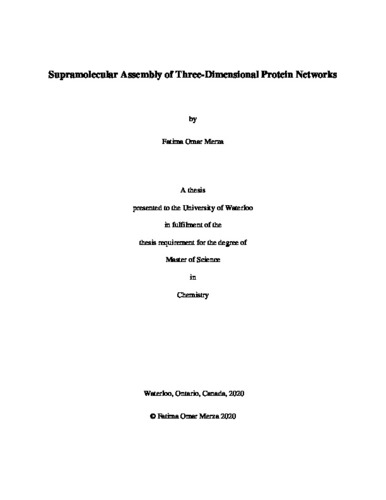| dc.description.abstract | Intense interest is being focused on self-assembling biological networks and their practical applications, making them powerful tools for the next-generation of advanced bionanomaterials. This thesis project explores potential strategies to fabricate versatile protein networks in a supramolecular fashion. That will create a functionalized scaffold through the chemical attachment of a diverse range of molecules such as: enzymes, magnetic nanoparticles, and photolabile-based drugs.
The thesis hypothesis was that advanced bionanomaterial scaffolds could be fabricated from capsule proteins and linkers employing the high affinity biotin-avidin interaction. This bio-based platform leverages a cage-like proteinaceous molecule, which is ferritin. The protein ferritin is expressed in the tissues of many life forms and it features a rigid spherical structure with robust biochemical and thermophilic properties making it an attractive component for three-dimensional protein network design. Bioconjugation is an important tool in the fabrication of complex bionanomaterials.
The ferritin capsule protein was incorporated in the network by implementing bioconjugate techniques on its exterior surface, where the lysine residues were the main focus to undergo reactions on in order to display free biotin molecules on the protein’s surface. These biotins, along with the protein avidin, a protein having high affinity to biotin, self-associate via avidin-biotin complexation, and form the basis of a cross-linked network.
A wide range of PEGylated molecules were investigated to surface-modify ferritin to showcase the potential for functional diversity. Additionally, a multi-step bioconjugation strategy was developed to successfully tag ferritin with aldehyde-containing molecules, which can add further novelty to the protein network. The designed and functionalized networks that are demonstrated in this research could potentially be capable of serving as a multi-enzyme protein complex, a smart photoreleased-drug bandage, and a porous filtration biomembrane. | en |

